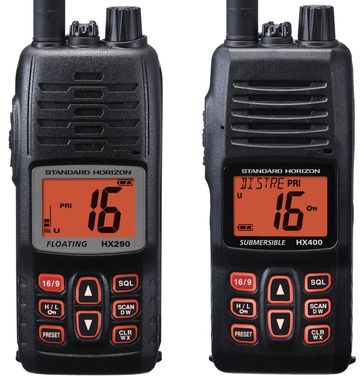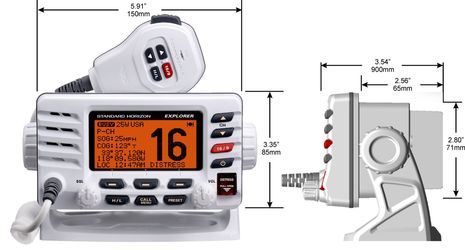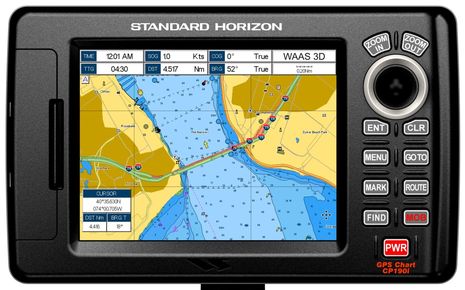Standard Horizon 2011, new everything!
Today Standard Horizon formally announced a pant load of new VHF and MFD products. Most feature good, if incremental, changes; many have already have been shown at the Fall boat shows; and some are even listed at online stores…but at least one will likely blow your mind! Today I’m going to run through some highlights, with links to more detail. So how about the “ultra compact” dimensions of the Explorer GX1600 VHF seen above? Won’t that fit in many places most radios wouldn’t? It’s also a full Class D DSC set for only $170 MAP, as is the new Eclipse DSC+ GX1150 for only $130. Class D, incidentally, becomes the minimum standard for all new fixed VHFs in the U.S. as the FCC finally killed the somewhat crippled SC101 standard, and if you’re not familiar with those standards check out this explanation (and note the circa 2007 VHF pricing)…
Standard Horizon also has two new handhelds. The HX290 is billed as an “extremely affordable 5W floating VHF” at $120 while the somewhat similar-looking $200 HX400 is a commercial handheld that can be programmed with 40 Land Mobile Radio (LMR) channels. Note that the “sold out” notations at these online stores are a bit disingenuous as all these products aren’t scheduled to ship until January, and a couple of these radios are not yet FCC approved, which means they are truly not for sale yet. And MAP stands for minimum advertised price, which is generally closer to the real price than the more standard MSRP (manufacturer’s suggested retail price).
SH’s hit VHF/AIS combo unit, the Matrix GX2100, will become the GX2150 in January, with new features briefly described thusly: “GPS in / DSC out 4800 and 38400 baud rate selections (Allows connection to GPS Chart Plotter with 1 NMEA IN/OUT), selectable True
and Magnetic readings for AIS target and PA/FOG simultaneous operation with AIS display, GPS status page.”
 Standard is also refreshing its whole MFD line, and the most significant change I notice is that the built-in charts cover not only the coastal U.S.A. but also the Great Lakes, Canada, Bahamas, Caribbean, Cuba, Mexico, Puerto Rico, and Central America! I asked for more detail and learned they are indeed C-Map charts that include “depth contours and spot soundings to 66 feet on lower scale
Standard is also refreshing its whole MFD line, and the most significant change I notice is that the built-in charts cover not only the coastal U.S.A. but also the Great Lakes, Canada, Bahamas, Caribbean, Cuba, Mexico, Puerto Rico, and Central America! I asked for more detail and learned they are indeed C-Map charts that include “depth contours and spot soundings to 66 feet on lower scale
charts and 33 feet on higher scale charts” plus all nav-aids and relevant tide and current predictions. These built-in charts can be updated, and the displays also support C-Map NT+ and MAX chart cards. Given that the smallest model, the 5″ CP190i, has a MAP of only $600, won’t some cruisers buy it primarily as a chart portfolio in a waterproof, sunlight viewable package (with a built-in high performance GPS and many other features)? Could this be C-Map’s response to the inexpensive chart apps Navionics is distributing? Other new models are the 7″ CP390i and its fishfinding sibling the CPF390i, as well as the 12″ CP590, all with the expanded built-in chart regions.
The mind-blowing product that’s not online anywhere yet? Well, sorry, but I want to confirm one more detail. Soon, though.















Incidentally, it’s pretty well known in the trade that while Standard Horizon certainly manufactures its own radios, its plotters and MFDs are built by C-Map related company. That’s changed in a sense because C-Map’s big cartography division was sold to Jeppesen, but I think there’s still a close association.
https://panbo.com/archives/2006/08/boeingjeppesennobeltec_buy_cmap_meaning_.html
If it’s AIS B on the Matrix AIS I’m gonna cry.
Re: your comment; That explains the slightly alien feel of their chart plotters, both in hardware and firmware. This will sound weird, but the knobs and buttons on their plotters lack the tactile reassurance of their radios.
And if it’s AIS (receive only OK, but full AIS-B better) embedded in the CP190, and for a low price, then I’ll be pleased.
The full bage back cover of the Hamilton Marine catalog is an ad for SH. It states that the Matrix GX2100 is Class A & B receiver.
Doug
OK, here is my prediction on the “Mindblowing product”:
A chartplotter/VHF combo, with integrated AIS B transceiver, and the charts as you outlined for the previous products.
2nd guess – a handheld VHF radio with AIS B receive
Chris
Professional Mariner has a listing of the 2011 SH new products. Maybe the secret product is one of those?? Start a pool…..
I purchased the GX2100 and it is a great AIS receiver. I have seen vessels listed that are as far away as 37 miles!
That said, the rest of this radio is lacking. If you are using the hailer function and a VHF call comes in (on whatever channel you were last using) the radio reverts to a VHF radio, blasting the user with a high volumne and cutting off the hailer function.
The DSC function is also lacking. There is no way to disable auto-call-switching, so even if you are in the middle of a critical call, the danged radio will switch to the DSC emergency channel (16) and sound an ear splitting alarm. This lack of a disabling feature on the auto-call-switching has already caused loss of critical VHF communication between ships and assist tugs. The USCG has issued an alert about this situation. If I am talking to a vessel in a possible collision situation, I don’t want to be auto-switched to another channel.
The menu functions are complicated to the point that I had to create ‘cheat sheets’ to be able to get to the hailer and horn functions.
If you are in the radio mode, switching to the horn mode is so complicated that you will not be able to sound the horn in time to avoid collision.
Summary, It’s a great AIS receiver at a good price, but its a lousy radio, hailer, fog horn.
Larry H
The Standard Horizon GX-1600 is a nice radio, but I wonder why new models are not coming out with NMEA 2000 capability. Can it be true that manufacturers are not committing to the N2K trend?
I know, I know! It’s a chart plotter with everything! AIS transceiver, VHF DSC, radar, weather, N2K instruments, heart rate monitor, and slide show of all my Christmas pictures?
Larry;
Are you certain there is no way to disable the auto channel switching? This has been a requirement in ITU M.493 for quite a few years.
The problem with DSC radios is that the FCC allows the manufacturer to ‘self-certify’ the DSC functionality. At least with EPIRBs and AIS, the USCG makes sure this equipment is compliant with the relative standards…
I think it’s a great idea to have the company that is making the cartography produce the CP. Who else is going to know the ins and outs of their software?
Sandy was closest 😉
https://panbo.com/archives/2010/12/standard_horizon_cpn_series_the_first_internet_mfds.html
As I stare at my CP500 I just took off the boat, I wish for that NMEA 2000 feature as the Actisense 0183 to N2K isn’t as functional as it should be. When is Standard Horizon going to get with the game, N2K is the feature that is needed the most!
Rusty,
I directed that question to the tech support at S-H and they told me that there is no way to disable auto-channel-switching on any of their VHF radios. That was last spring so it’s possible that the new radios this year have the feature.
Larry H
What’s lacking on your Actisense product? Please tell, as I found them extremely willing to listen to their customers. If you speak out, they most likely will include the thing you desire into the next firmware version.
That’s what I love about microcontroller based products; the ability for early adopters to get the latest firmware and thus both keep the manufacturer and the early adopters happy.
Hi Larry, I think what S-H tech support told you, or should have, is that while they do not offer a way to permanently turn off DSC distress auto channel switching, you can cancel the switching any time you get a DSC call.
See page 50 of the manual. When a DSC alert is received the GX2000/GX2100 soft keys will give you a choice of:
ACCEPT: Press this key to accept the DSC distress call and to switch to Channel 16. (Note: If a key is not pressed for 10 seconds or longer the radio will automatically select Channel 16.)
PAUSE: Press this key to temporarily disable automatic switching to channel 16.
QUIT: Press this key to quit the automatic channel 16 switching and revert to the last selected working channel.
Personally I like this way of manually dispensing with nuisance DSC calls rather than turning off auto switching altogether, as the latter is more contrary to the whole safety aspect of DSC alerts. I plan to do an entry on this subject soon.
Larry,
I’ve been griping here and elsewhere about the non-configurable auto alarm / auto switch stuff with DSC.
No one seems to actually WORK on boats and need to use their radios reliably. Auto-switching, pop-up menues that default to doing something if you don’t read them fast enough does not create reliability.
When I’m doing something “important”, even if that’s just a close pass, I don’t want to be fumbling with my radio to read the screen and select the right buttons before it auto switches me over to some other channel. It’s discourteous and potentially dangerous.
Honestly, having equipment work in a way that is predicable and reliable is important.
When DSC first came out I was SUPER enthusiastic. Now I PRAY that the radio on boats I’m working are not DSC enabled because I end up turning them off more often then not and going back to a handheld.
Speaking of which, bringing equipment you are familiar with when working is a huge win. I know the COSCO Busan accident could probably have been prevented with a pocket GPS the pilot was familiar with, but anyone else find themselves bringing radio / pfd etc with them when working?
Also, what handhelds / radio’s have people really liked? I’ve moved from Icom’s M-72 (which felt absolutely great in hand) because the level one squelch seemed too high to standard horizon which has been fine. I’ve got the HX850s which does the alarm / auto switch DSC thing, but also a cheaper model that doesn’t that works really well with DSC.
What handhelds have people really loved and why? Any that aren’t so annoying on the DSC front?
My only other request beyond DSC alarm disable / softening and auto-switch disabling (prompt to switch is OK) would be to put a quick summary of setting changes on the back plastic. For SH you press WX and 16/9 to switch bands (USA / Intl etc). I’ve been caught out on that when traveling as each radio can be different and it’s not clear from the keys how to make the switch. Or put the cheat sheet under the battery in the battery compartment.